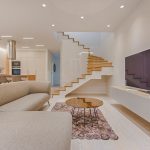Your home isn’t just a place where you simply come to sleep and eat – it’s a reflection of your taste, personality, and lifestyle. A well-designed home isn’t something you change every few years. It should be timeless, functional, and a source of pride for decades. That’s why designing your dream home requires thought, effort, and attention to detail. Every choice, from the architectural style to the smallest decor element, plays a role in shaping a space that feels uniquely yours.
If you want a home that looks stunning and serves your needs flawlessly, you can’t afford to overlook key design principles. From the landscape to the lighting, from floor plans to smart features, each aspect demands careful planning.
Whether you’re building from the ground up or renovating an existing space, this guide will walk you through the most important elements to consider.
The Importance of Landscaping: More Than Just Curb Appeal
A home’s exterior sets the tone before anyone steps inside. Thoughtful landscaping doesn’t just enhance beauty—it creates functionality, improves property value, and even extends your living space. Well-planned outdoor spaces can feel like a natural extension of your home, providing areas for relaxation, entertainment, or even work.
Landscape lighting design plays a crucial role here. The right lighting transforms a garden from a daytime retreat to a nighttime sanctuary. Pathway lights make walkways safer, uplighting highlights trees and architectural features, and soft lighting around patios or pools creates ambiance. Beyond aesthetics, outdoor lighting improves security, discouraging intruders and making your home feel safer.
Sustainability should also be considered. Choosing native plants reduces water consumption and maintenance, while efficient irrigation systems keep your lawn and garden thriving without excessive waste. Hardscaping elements like stone pathways, fire pits, and pergolas add both structure and charm. Whether you prefer a lush green lawn or a more minimalist rock garden, landscaping should complement your home’s architecture.
Floor Plan Flow: Designing for Comfort and Functionality
The layout of your home affects everything from daily convenience to long-term resale value. A good floor plan ensures a seamless flow between spaces while maintaining privacy where needed. Open-concept designs remain popular for their airy feel, but they don’t work for everyone. Families with young children may prefer separate spaces where noise doesn’t carry as much.
Zoning is an important factor in a well-designed home. High-traffic areas like the kitchen and living room should be easily accessible, while quieter spaces like bedrooms and offices should be more private. Thoughtful placement of staircases, hallways, and doors makes movement through the home feel natural.
Storage solutions should be built into the floor plan, not treated as an afterthought. Walk-in closets, built-in shelves, and under-stair storage can make a big difference in keeping a home organized. Functional spaces like mudrooms, laundry rooms, and pantries also improve daily efficiency. A well-designed floor plan is one that fits your needs effortlessly while remaining adaptable for the future.
Maximizing Natural Light: The Key to a Bright and Airy Home
Light changes the way a home feels. Natural light makes a space feel larger, more open, and inviting. It also has psychological and health benefits, improving mood and boosting productivity. Maximizing natural light starts with window placement. South-facing windows provide consistent daylight, while skylights bring light into areas where traditional windows aren’t an option.
Floor-to-ceiling windows and sliding glass doors blur the line between indoors and outdoors, making spaces feel more expansive. Light-colored walls, mirrors, and glass furniture help reflect natural light, enhancing brightness without relying solely on artificial lighting. Properly designed homes don’t just maximize natural light; they also consider how to control it. Automated blinds and smart glass technology allow homeowners to adjust brightness throughout the day. A bright home is not just beautiful—it’s more energy-efficient and pleasant to live in.
Smart Home Technology: Convenience Meets Modern Living
Technology is transforming home design, making life more efficient, secure, and comfortable. Smart home features aren’t just about luxury anymore; they’re becoming essentials in modern living. Home automation systems let you control lighting, security, temperature, and even appliances from your phone or voice assistant.
Smart lighting can be programmed to adjust throughout the day, mimicking natural light patterns. Thermostats learn your habits and optimize energy use, cutting costs while keeping your home comfortable. Security systems with cameras, motion sensors, and remote access provide peace of mind whether you’re home or away.
As technology continues to advance, smart homes are no longer just futuristic concepts—they’re an integral part of designing a home that works for you.
Kitchen Design: Where Function Meets Style
The kitchen is where family and friends gather to cook, eat, and connect. Therefore, a well-designed kitchen needs to strike a balance between style and functionality. A beautiful space is meaningless if it doesn’t support your daily routines efficiently.
One of the most important aspects of kitchen design is the layout. The “work triangle” concept always works best. Are you unaware of this concept? It basically involves placing the sink, stove, and refrigerator in a triangular pattern to ensure that everything is within easy reach. This layout reduces unnecessary movement, making cooking more efficient. If you have the space, adding an island can provide extra storage, seating, and prep area.
Storage is another major factor in a functional kitchen. Deep drawers, pull-out shelves, and custom cabinetry help keep everything organized and easily accessible. Choosing durable materials for countertops and backsplashes, like quartz or granite, ensures that your kitchen will stand up to daily use while maintaining its elegance.
The Perfect Bathroom: A Spa-Like Retreat at Home
Bathrooms should be more than just functional spaces—they should be places of relaxation and comfort. A well-designed bathroom can feel like a personal spa, offering a sense of luxury even in the smallest details.
A key decision in bathroom design is whether to prioritize a large walk-in shower, a soaking tub, or both. Walk-in showers with frameless glass doors create a sleek, modern look and are easy to clean. Freestanding tubs, on the other hand, offer a relaxing retreat, especially when paired with soft lighting and natural materials.
Comfort features can also elevate a bathroom’s functionality. Heated floors provide warmth on cold mornings, while towel warmers add a touch of luxury. Smart mirrors with built-in lighting and anti-fog technology improve visibility and convenience.
By focusing on both beauty and practicality, a well-designed bathroom becomes a place to unwind and recharge, adding long-term value to your home.
Designing a dream home is about more than aesthetics—it’s about creating a space that reflects your lifestyle, values, and long-term needs. By focusing on thoughtful design choices, you can create a home that stands the test of time. Whether you prioritize energy efficiency, timeless materials, or a seamless indoor-outdoor connection, each decision shapes the place you’ll call home for years to come. With careful planning and attention to detail, your dream home will be a space you cherish every day.








